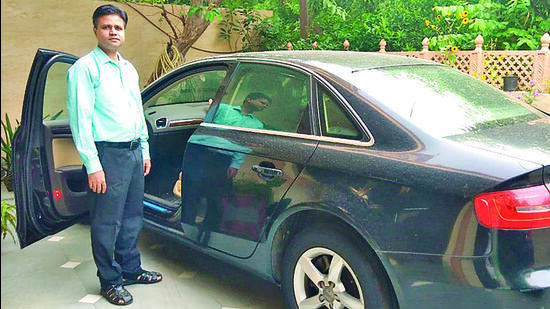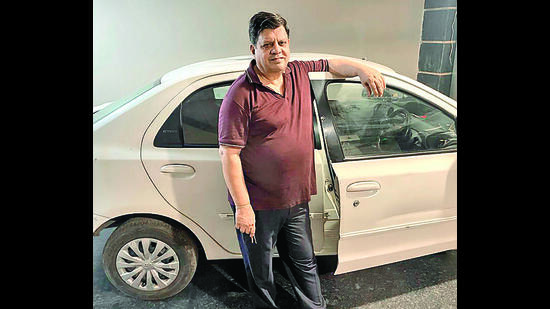Owners question ‘end of life rules’ amid towing of old vehicles in Delhi
Owners of such vehicles have three options — transfer them out of Delhi-NCR, scrap them, or keep them parked without use
Nikhil Jain, a resident of west Delhi’s Paschim Vihar, owns four cars. One of his vehicles — a 2003-model Toyota Corolla — was towed away from outside his house on December 30, 2022. The price of the car was not a concern for Jain. However, its value was much more than what a second-hand dealer or a scrapper would give. This prompted Jain to file a writ petition in the Delhi high court against the way his car was towed. He has now obtained a stay against the scrapping of the vehicle till the court takes a final decision.

“I learnt how to drive in this car when I was in college. I have always driven this car with a lot of care and it is much less polluting than a new vehicle,” said Jain.
Jain’s vehicle was taken away as the Supreme Court 2018 affirmed a 2014 National Green Tribunal ruling that banned petrol and CNG vehicles older than 15 years and diesels older than 10 years from being used in the National Capital Region (NCR) over air pollution concerns. The order deemed over 5.5 million vehicles in Delhi as “end of legal life” vehicles (ELVs), which were automatically deregistered by the Delhi government.
Owners of these vehicles have three options — transfer them out of Delhi-NCR to enlisted districts for use, scrap them, or keep them parked in a private space without use.
The Delhi transport department resumed a drive to tow away all such ELVs to be scrapped in May, which has led to resentment among residents who are questioning the administration’s right to decide the fate of a private asset. Many have said that the enforcement teams of the transport department were picking up vehicles parked in private properties without notice.
The department, however, says it is following the law.
The issue escalated after the department started an intensive campaign against ELVs from May.
On Wednesday, political analyst Tehseen Poonawala shared a video on social media describing how his car was forcibly taken from his private property and smashed before being towed away to be scrapped.
“I was having lunch and my old car was parked in the R Block of Greater Kailash I when the transport team picked up my vehicle. Someone told my driver who informed me. We rushed to the spot. I was shocked to see that they had already smashed the windows of my car and had towed it to the main road before I could even reach the spot. I tried talking to the officials but they refused to engage,” said Poonawalla.
He added that there was no financial reason for him to not dispose of his car. He said that he has no intention of using it if the law does not permit it, but he also did not want to give it away.
“The scrappers would give around ₹50,000 for it but it is of more value to me as my dog died in that car,” said Poonawalla, adding that he will file a case in the Delhi high court next week regarding the “autocratic move” by the transport department.
To be sure, vehicular emissions contribute only around 9% of the PM10 load and around 20% of the PM2.5 load in Delhi, according to a 2016 study by IIT-Kanpur. Particles formed due to smoke from industries and various other sources and burning of garbage were the two main contributors to air pollution in winters, according to preliminary findings of the Delhi government’s real-time source apportionment study in January.
Poonawalla’s vehicle is now at a scrapping facility in Uttar Pradesh’s Baghpat district. Officials of the car scrapping facility, Go Green ELV Handlers, said that they were one of the few licensed and authorised car scrapping/dismantling facilities.
“The Honda CRV (BS stage 2 vehicle) is now with us. It was a deregistered vehicle (fitness expired on August 30, 2022) and the insurance also expired on June 1, 2022. Those who seized the vehicle were not our staff but from the enforcement wing of the Delhi transport department. Once the vehicle owner approaches us, we will give them the certificate of deposit. Thereafter, the vehicle scrapping procedure is initiated,” said RP Malik, a working partner at the firm.
Malik added that if a vehicle’s owner approaches them after it is towed, and agrees to scrap it, the dismantling process is completed within 7-8 days. In other cases, the vehicle is scrapped after 90 days if the vehicle owner does not agree or has any objections.

“In case the vehicle was brought by the transport department, the amount attracts a deduction of 35% on account of the removal of tyres, battery, plastic, rubber, and wiring and these further reduce the unladen weight of the vehicle. Another 10% is deducted as charges for the facility. However, in case the vehicle owner brings his vehicle personally, the deduction is lesser and they can get up to 75% of the unladen weight of the vehicle,” said Malik.
The angst of residents whose vehicles are being towed away without permission has garnered support on social media platforms and from other people who have been contesting the NGT order and raising questions regarding the logic of the decision. Transport department data suggests that not many people want to get their vehicles scrapped.
Officials said that their actions have been in accordance with government directives. “The transport department officials act only following the Commission for Air Quality Management (CAQM) orders, based on which an ELV parked on a public road or street or an ELV found plying on the road is impounded and handed over to scrappers,” said Ashish Kundra, transport secretary cum commissioner, Delhi transport department.
According to the records accessed by HT, less than 1% of the deregistered vehicles in Delhi have been scrapped so far. The Delhi transport department said there were 13 million vehicles registered in Delhi, of which 5.5 million have reached the end of their legal life and have been deregistered.
Till December 2022, the eight authorised scrappers in Delhi scrapped 36,000 vehicles overall, and the transport teams impounded and scrapped 6,500 additional vehicles this year. This is about 0.7% of the total ELVs in Delhi, though the department does not have any record of owners who voluntarily got their vehicles scrapped this year.
Anuj Agrawal, 41, runs a travel business in Gurugram and owns two cars that need to be scrapped according to the NGT order.
Agrawal has shifted his Honda City to Indore but was unable to part with his dream car — an Audi A4 2.0. He said that there were many issues with the order, and with the assumption that older vehicles were necessarily more polluting and should be deregistered.
“My registration certificate (RC) and road tax are valid till 2027. Why should we be paying tax for that period if the vehicle cannot be driven for 15 years? Sending it outside the state is also a difficult task. When I tried transferring my car to Rajasthan, I was asked to pay ₹3.25 lakh as tax while paid ₹2 lakh when I first bought it. I tried getting in touch with companies that can convert vehicles to electric, but they had no technology that could make this possible as it only works on vehicles with 800-1000cc engines,” said Agrawal.
Ritvik Kalsi, 20, is a student who lives with his family in west Delhi’s Rajouri Garden. His father has refused to sell their 15-year-old car because he considers it lucky for him. Kalsi has questions about how the criteria for ELVs were fixed.
“How can age be the determining factor for how polluting a vehicle is? There is so much more to a car than its manufacturing date. It matters whether the car has been driven enough and how it has been maintained. This (impounding and scrapping ELVs) is just arbitrary and there should be a fitness test to declare a vehicle unfit in terms of pollution generated,” said Kalsi.
Some other residents said that the very premise of the NGT order needs to be questioned before vehicles can be impounded or scrapped.
“The order is to limit pollution in NCR. However, we have much evidence to say that the overall carbon footprint of disposing of an old car and getting a new one is much higher than keeping an old car. Besides, governments need to increase focus on how old cars can be converted to electric. It should also be noted that scrapping agencies are also polluting industries,” said Nikhil Jain.
Meanwhile, experts and transport planners echoed similar concerns and said that systematic reforms were required in how vehicles were categorised as polluting or non-polluting.
“The easiest way to go about this is to restrict usage of vehicles with older technology that are assumed to be more polluting. However, this is a major regulatory flaw and grossly polluting vehicles should be identified based on in-use vehicle emission testing that is done across European countries. Also, the major pollutants in Delhi are PM10 and PM2.5, which are not even checked while handing over the Pollution Under Control (PUC) certificates. It is high time that we also start re-imagining our PUC regime and bring structural changes,” said Amit Bhatt, managing director (India), International Council of Clean Transport (ICCT).
Stay updated with all top Cities including, Bengaluru, Delhi, Mumbai and more across India. Stay informed on the latest happenings in World News along with Delhi Election 2025 and Delhi Election Result 2025 Live, New Delhi Election Result Live, Kalkaji Election Result Live at Hindustan Times.
Stay updated with all top Cities including, Bengaluru, Delhi, Mumbai and more across India. Stay informed on the latest happenings in World News along with Delhi Election 2025 and Delhi Election Result 2025 Live, New Delhi Election Result Live, Kalkaji Election Result Live at Hindustan Times.
All Access.
One Subscription.
Get 360° coverage—from daily headlines
to 100 year archives.



HT App & Website







